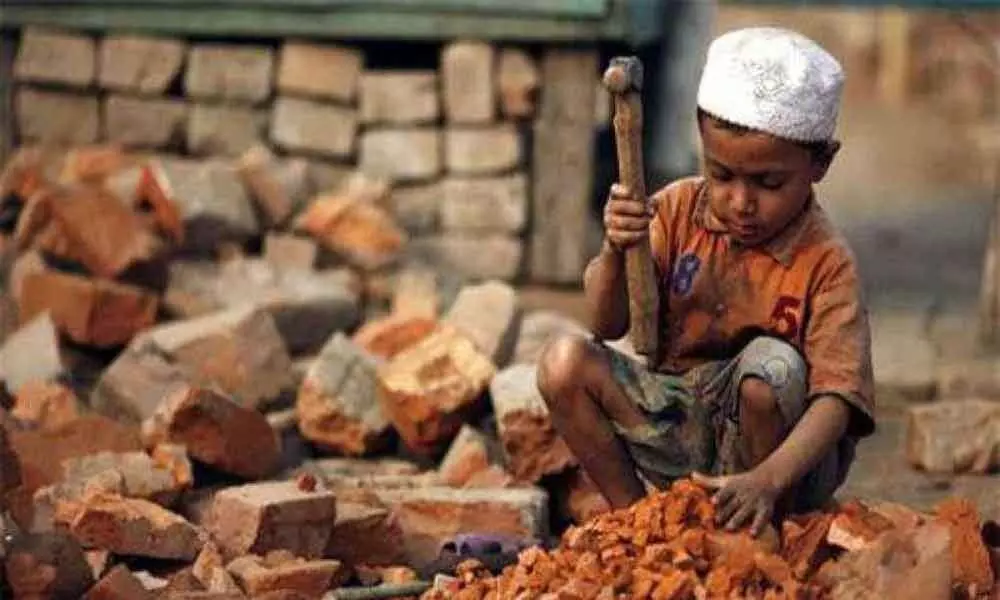Child labour at high risk of being afflicted
 Child labour at high risk of being afflicted
Child labour at high risk of being afflictedAccording to UNESCO report on April 2020, there are 1.5 billion learners and representing more than 91 percentage of total enrolled learners are out of schools from 188 counties around the world.
According to UNESCO report on April 2020, there are 1.5 billion learners and representing more than 91 percentage of total enrolled learners are out of schools from 188 counties around the world. The world has never experienced such a dramatic impact on human capital investment, and the consequences of COVID-19 on economic, social, and political indicators are unknown but certainly has become dramatic.
This may effect on children lives and they are more likely to be engaged in harmful work. Because, the virus spread has been created lot of destruction in the job market for daily wage labourers and migrant families. This will lead to an aggravate the child protection issues and directly harms their health, safety and their overall development. Children of migrant families are one of the vulnerable groups who deprived from the right to education those left behind, who migrate with their parents are likely to be most affected by the ongoing crisis.
A total of 152 million children – 64 million girls and 88 million boys – are in child labour globally, accounting for almost one in ten of all children worldwide. Nearly half of these children are engaged in hazardous work and 71 percent of all children engaged in child labour, by far the largest share of child labour.
As per Census 2011, the total child population in India in the age group (5-14) years is 259.6 million. Of these, 10.1 million (3.9% of total child population) are working, either as 'main worker' or as 'marginal worker'. In addition, more than 42.7 million children in India are out of school as per the ILO report 2017. The efforts under UN Sustainable Development Goal 8.7, which aimed to eradicate all forms of child labour by 2025 has geared up in creating awareness on protecting children from work. But the Covid situation has reversed and it is alarmingthat, children will become more vulnerable. The economic downturns among marginal communities due to lockdown typically lead child turn to work as labour, getting child marriages, trafficking, sexual exploitation, migration and displacement of children-who already on great risk and unsafe.
In the context of Telugu States, as per the report by Unicef & CESS 2011, there are 3,80,422 child labour in Andhra Pradesh, 5 out of every 100 children are child labour, among child labour, 51 per cent are boys and 49 per cent are girls. According to 2011 census, Telangana state is having 3,72,582 child labour, with high incidence prevalence in agriculture, construction and other domestic work.
Save the Children advocates for legislative reforms that prohibit employment of children up to the age of 14 years in all occupations and processes to correspond to the Right to Free and Compulsory Education Act 2009. For 15-18-year-old, work should be strictly regulated and only permitted in a decent work environment. Securing livelihoods to the parents of children engage in labour should be an integral part to the strategy of eliminating child labour. Save the Children has initiated various projects and programmes in these lines. Recently initiated a special project for ensuring formal education to the children who belong to waste picking families in Bengaluru urban with the support of H&M Foundation in partnering with various NGOs as collective.
To overcome all these challenges, government has to work on an immediate short and long term solutions and strategies to protect child rights as non-negotiable. Designing livelihood options for migrant and wage labourers to regain their livelihoods and incomes, strong legal enforcement to protect children right to education, health and development.Community based mechanisms also to be strengthened to vigilant on child protection issues to support district and state level child protection units to eliminate child labour.
(The author is Education Lead, South India, Save the Children. The above views and recommendations have made based on the experience and desk reviews of various reports. The organisation is not responsible for the views and comments included in the article)

